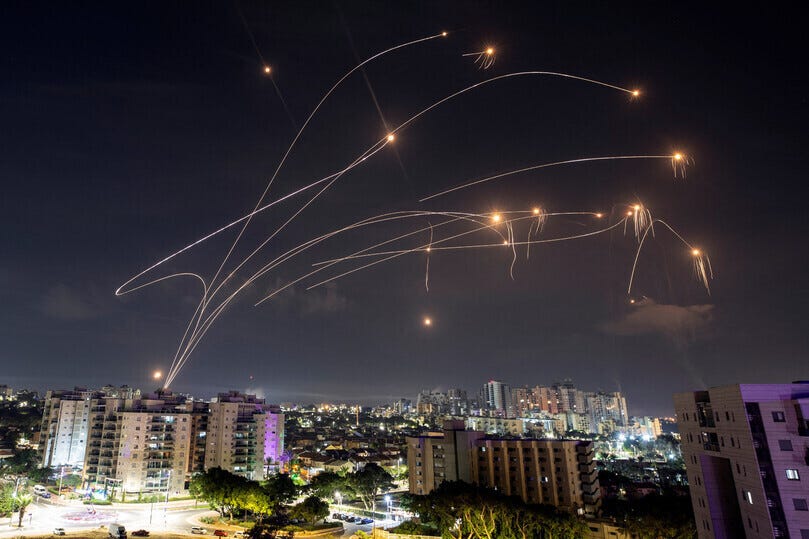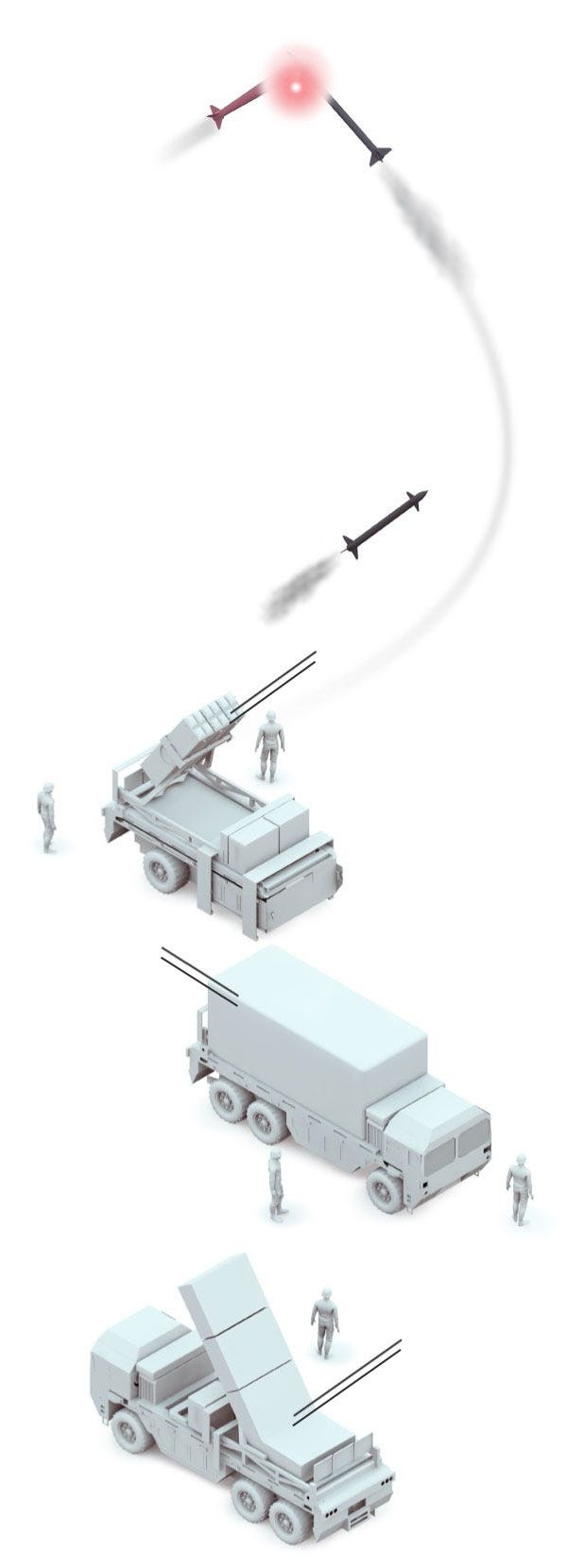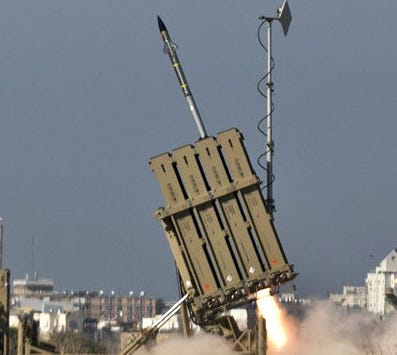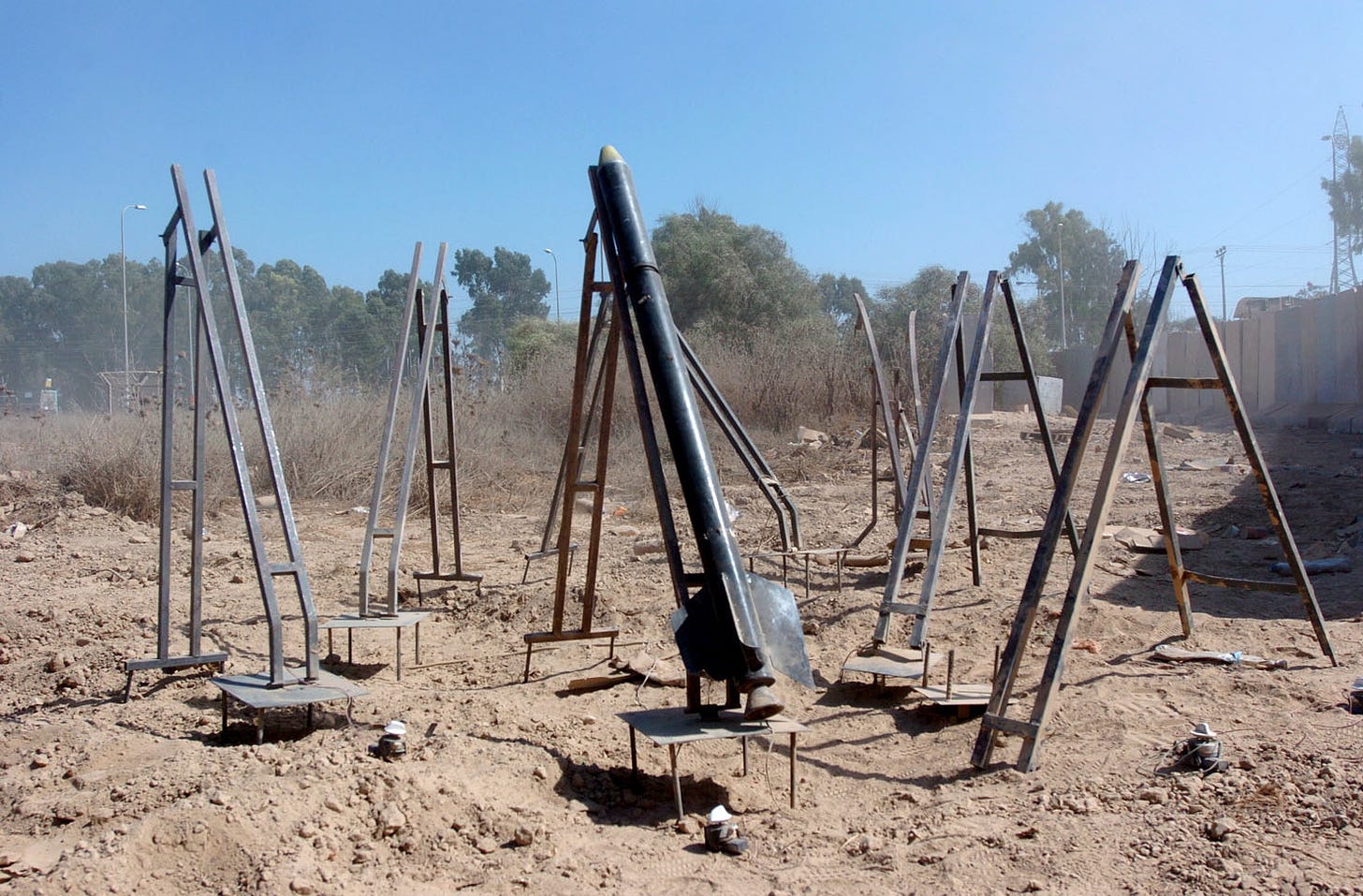To begin with, shooting a rocket out of the sky did not used to be possible. Even if it’s a big one, a rocket is too small and fast to see with the naked eye. The missiles being fired at Israel are traveling through the air at greater than the speed of sound, somewhere around 1,000 miles per hour or even faster. Think about it: you are trying to hit a target that’s about 8 feet long and only about five inches in diameter. Shooting at one would be like throwing a spear and trying to hit it with a rock.
By now, you have probably seen footage of missiles fired at Israel by Hamas in Gaza being shot down by Israel’s anti-missile system known as the Iron Dome. This morning, NBC’s Richard Engel was reporting from the Israeli coastal city of Ashkelon when air raid sirens sounded. Overhead in the sky behind him, you could see the white contrails of a barrage of Hamas missiles as they took flight, heading steeply upward into Israeli airspace. Then you could see other contrails heading upward much faster than the Hamas missiles, some of them curving sharply as the anti-missile missiles locked on and followed their targets. Then there were white puffs of smoke as the anti-missile missiles struck their targets. At night, as in the photo above, the missile contrails appear as if they are photo negatives, reddish-yellow streaks across the black night sky.
If you were the news on MSNBC, you saw the result of the Iron Dome system at work, but you didn’t see the whole thing. On the ground, stationed at key points within Israel around Gaza, were the missile batteries of the Iron Dome system. The batteries consist of three elements: truck mounted launchers with a pod of twenty Tamir missiles, typically three launchers to a battery; a truck containing the missile control system; and a truck-mounted radar array that tracks incoming missiles, shown here in an illustration from Rafael Advanced Defense Systems, the Iron Dome’s manufacturer.
The Tamir is a long, thin missile weighing a total of about 190 pounds including its 20-pound warhead, shown below leaving its launcher. The missile is about 10 feet long, six inches in diameter, and is capable of traveling at more than twice the speed of sound. The Tamir has fins that are controlled by the radar-guided ground unit until it gets close to the target. At that time, a radar within the missile takes over and guides it until it gets close to the target, at which point a laser proximity fuse takes over. The laser measures the distance to the target, and at a pre-set distance sets off the warhead. The Tamir isn’t designed to hit the target missile, but rather to explode once it is within the range of the spray cone of shrapnel from its warhead that hits the target in multiple places and bring it down.
Can you imagine? Everything happens within seconds: the radar picks up the missile just after it is launched and begins sending its location data to the missile control station on the truck. The Tamir is launched automatically once the launcher gets the target and begins being guided by the mobile control unit. The end life of the Tamir takes place in mili-seconds when the laser proximity fuse takes over.
And there is more: I couldn’t find any data about how the Iron Dome batteries are linked, probably because the information is top secret, but it is known that there is a linkage between individual launchers and between batteries that prevents multiple launchers from firing multiple Tamir missiles at the same target. There is a good reason for this: The kind of “homemade” Qassam rockets being fired by Hamas can be assembled using ordinary hand tools and cost about $800 apiece. The Tamir missile, with all its computerized guidance systems and internal radar and laser proximity fuse costs about $60,000.
Hamas has fired in excess of 3,000 rockets at Israel since Saturday, perhaps as many as 5,000 so far. In the first barrage on Saturday morning, Hamas fired as many as 2,500 rockets within minutes, overwhelming the Iron Dome defenses with the sheer number of missiles that were in the air at once, confusing both the radar and mobile controllers of the launch systems.
How did Hamas acquire such a large number of missiles is the question of the day. Israel’s defense ministry and the Pentagon agree that the components for the Qassam came from Iran, but how did Hamas manage to get them past the military blockade Israel has erected around Gaza, including the fence and naval blockade? My friend John Broder, an excellent reporter who lived in Israel for many years, wrote a piece in Jeff Stein’s SpyTalk Substack yesterday that spells out what is known about the Hamas smuggling system. According to Broder, beginning in 2012, Iran began smuggling missile components on ships nominally bound for European ports on the Mediterranean Sea. Once the ships left Iranian ports, however, they sailed around the Arabian Peninsula and went through the Red Sea to Port Sudan. I’ll let Broder take it from here: “The missile components were offloaded to warehouses operated by Iran’s Quds Forces with the approval of Sudan’s Islamist President Omar al-Bashir. While the Iranian cargo vessels continued through the Suez Canal to their destinations, Iranian agents in Sudan moved the missile components overland through Egypt to the Sinai Peninsula, where nomadic Bedouin tribesmen working with Hamas smuggled them into Gaza through tunnels dug under the Gaza-Egyptian border. Iranian-trained Hamas engineers then reassembled the parts into operable missiles.”
Smuggling channels have changed, at one point involving Libyan rebel arms dealers and schemes to avoid Israel’s naval blockade of Gaza that involved “floating pallets filled with missile components and missile manufacturing machinery into the sea off the Gaza coast, where they were retrieved by Palestinian fishermen,” according to Broder. At this point, given the number of missiles Hamas has been able to either acquire or build themselves, their operation is probably a combination of methods to avoid Israel’s blockade of Gaza. Smuggling missile components, I would guess, is probably a bit like smuggling drugs. When there is a need, smugglers find a way.
North of Israel in Lebanon and Syria, Hezbollah is suspected of having at least 100,000 rockets ready to launch at Israel.
Which leaves Israel’s Iron Dome to protect the country from more Hamas missile attacks. Broder estimates that Hamas may have been able to smuggle enough components for as many as 15,000 missiles, which means that they could still have a lot left to go. The missiles are easy to assemble and so are the launchers, shown below, that can be erected, used, and folded up and hidden away in moments.
Israel may have an Iron Dome overhead, but down on the surface of the earth, there is no absolute defense against an enemy determined to kill as many Israelis in any way they can, as we saw on Saturday when Hamas militants entered Israel on foot, on motorcycles, in cars and trucks, and by powered hang gliders and small boats. It is unknown at this point how many Hamas militants breached Israel’s defenses, but given the number of Israel’s dead – now exceeding 900 – the number must have been in the hundreds.
For the moment, Israel is launching airstrikes on what they call “Hamas targets” within Gaza, but it’s only a matter of time before they go into Gaza with ground forces, including tanks and armored personnel carriers, with a mission to kill Hamas militants and search for hostages.
Thousands more may die on both sides before this war is over.







Thank you, Lucian. Your columns explaining these weapons and how they're used are excellent.
OK, this leads me to the obvious question: why aren't The NYT, The Washington Post, and The Guardian giving these explanations? I read them all. Maybe I'm missing something.
As I've written before, this is why I subscribe.
"I couldn’t find any data about how the Iron Dome batteries are linked, probably because the information is top secret,.." Did you try asking Trump?